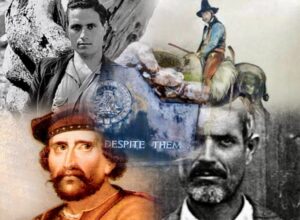Call for team mates
(Correne Coetzer) The Austrian mountain and ski guide, Christoph Höbenreich, plans to take a group of 4 or 5 climbers to climb this volcano, January 05 to 23, 2017. The climb should take 12 days and in total 19 days travel. He is calling for climbers to join and gives details about the mountain and expedition.
PYTHOM: You have climbing plans in Antarctica in 2017. What are you going to do there?
CHRISTOPH: Do you dream of the unexplored and crave the extraordinary? This is the ultimate mountaineering expedition to Antarctica‘s tallest volcano and one of the most remote and rarely climbed peaks on this planet: Mount Sidley, 4285 meters.
The West-Antarctic Ice Sheet is like no other place on Earth: Extreme, remote, cold and windswept. The harsh elements and austere immensity of this ice desert renders it the world‘s premier adventuring playground. Here spectacular and beautiful Mount Sidley is the target of our special expedition in January 2017 and the highlight of our ambitious Volcanic Seven Summits project. We plan to climb the peak via an epic route in the spirit of real adventure and traverse its three summits. The mountain‘s remote setting, interesting and varied climbing and its status as one of the Volcanic Seven Summits make it a “must do” for adventurous mountaineers and true “volcanoholics”.
PYTHOM: Tell us more about the area please.
CHRISTOPH: Mount Sidley, 4285 meters, is a huge and remote mountain set on the white expanse of the West-Antarctic ice sheet. The shield volcano is the continent´s tallest volcano and the highest mountain of Marie-Byrd-Land. The majestic, mostly snow covered peak features a 5 kilometers wide caldera and sheer walled 1200 meters deep amphitheater, created by an explosive eruption 4,7 million years ago. Blue ice slopes guard the upper mountain and fantastical snow “mushrooms” sprout along the upper ridge, creating an elaborate maze to the summit.
Marie-Byrd-Land is located in West-Antarctica between 158° W and 103°24’ W and covers an area of 1.6 million square kilometers, three times the size of France. Even for Antarctic standards it is a very rarely visited region and is considered the largest “no man’s land” on earth. Unlike all other territorial sectors in Antarctica Marie-Byrd-Land is not claimed by any nation in the world. Also there are no fishing fleets along its shores, no artificial moorings, aircraft runways or landing strips and not even research stations. It is pure polar wilderness.
The Executive Committee Range, which stretches about 80 kilometers from North to South, includes Mount Sidley. The gigantic volcano rises 2200 meters above the ice plateau. Very close to Mount Sidley the ice-covered and more than 2500 meters deep Bentley Subglacial Trench is the deepest point on earth not covered by sea.
PYTHOM: What skiing and climbing are involved?
CHRISTOPH: Our ski aircraft lands near Mount Sidley and we establish base camp at approximately 2000 meters altitude, below the imposing bulk of the mountain. We climb alpine style, setting two intermediate camps on the mountain and dragging or carrying our food and equipment with us. We may ski to low camp on hard packed, wind blown snow, but most of the climb will be done with crampons.
PYTHOM: How many people?
CHRISTOPH: 4 to 5 + 1 polar-mountainguide.
PYTHOM: How difficult is this climb? What are the challenges on Sidley? What skills level and fitness are required? Weight of backpack?
CHRISTOPH: Although Mount Sidley is not technically difficult, it is a serious mountain due to its extremely remote location, the cold of up to -30C, elevation of 4285 meters at a very high latitude of 77°S, which makes the mountain “feel” much higher. You should have experience with multi-day peaks in cold environments; climbing at altitude 4500 meters and with unsupported alpine-style ascents in winter conditions. Proficiency with ice axe and crampons on slopes up to 45 degrees and with roped glacier travel carrying a 20 kg backpack is essential.
PYTHOM: How does it compare to Vinson?
CHRISTOPH: Mount Sidley was first climbed as late as January 11, 1990 by New Zealander Bill Atkinson, followed by two more ascents in the early 1990‘s by US Antarctic Scientific Program field parties. It wasn‘t until 2010 that Sidley saw its third ascent.
While Mount Vinson (4892 meters), the highest peak in Antarctica, has already been climbed several hundred times, has an installed basecamp infrastructure, designated high camps and fixed ropes, until now only a handful of mountaineers and true explorers stood on top of Antarctica´s highest volcano Mount Sidley. This is the peak for those with sense for exploration looking for real adventures far off the beaten tracks in real polar solitude.
PYTHOM: Logistics: How do you get to Sidley?
CHRISTOPH: We begin the journey in the southern gateway city of Punta Arenas, Chile. From Punta Arenas we fly in one of the most stunning aircrafts in polar aviation, a specially equipped Ilyushin IL76 transport jet, 4¼ hrs to the American Union Glacier airbase in Antarctica´s Ellsworth Mountains. We land on the ice runway and settle in at Union Glacier Camp. From ALEs Union Glacier Camp we fly almost 900 kilometers over the spectacular mountains and the vast emptiness of West-Antarctica to the remote Executive Committee Range.
PYTHOM: How long is the climb (given good weather). Expected temperatures?
CHRISTOPH: -15 to -30°C.
We have five days for the climb and 2 spare days in case of bad weather. But storms and blizzards are rare up here at this time of the year and we are more likely to experience the fragile stillness of the high pressure system in the high and dry Antarctic interior. Warm clothing, heat generating activity, a high caloric food and cosy camping gear make the elements of Antarctica not only tolerable but truly enjoyable. We will experience 24 hour daylight. So there is no shortage of time to really see and feel the true Antarctica like just very few people have experienced the icy paradise before.
Summit day offers spectacular views as we follow the summit ridge along the rim of the caldera. Below us the sheer walls of the Weiss Amphitheater drop away 1200 meters. We weave our way between a maze of fantastical ice “mushrooms”. These spectacular snow features are formed by wind and moisture depositing rime ice on small obstacles, over the years evolving into massive structures. Our select group has skied and climbed in one of the most stunning landscapes on this planet to the summit of one of the most remote peaks on earth – a magnificent achievement that will live with us for the rest of our life. Following our summit success we return to high camp and retrace our steps back to our base camp.
BACKGROUND:
Leader for this expedition is Christoph Höbenreich, a passionate “polarnik” from Austria. Since 1993 Christoph is involved in polar adventure and guiding with qualifications as a professional UIAGM mountain and ski guide and an endorsement as IPGA polarguide. He is also a geographer holding a PhD-degree. Christoph is highly experienced in Arctic and Antarctic travel as he led several polar expeditions and worked with outstanding polar projects in both the Arctic and Antarctic. He was manager of Mount Vinson Base Camp, guided five successful climbs to the summit of Mount Vinson in the Ellsworth Range and a successful climb of legendary Mount Scott on the Antarctic Peninsula, explored unknown mountains in Queen Maud Land and led two ski last degree teams to the Geographic South Pole, and across South Georgia Island in the footsteps of Ernest Shackleton.
#antarctica #mountsidley #volcano
Interested to join? Contact: christoph.hoebenreich( at )aon.at.






